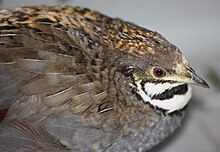Little Quail
| Little Quail | ||||||||||
|---|---|---|---|---|---|---|---|---|---|---|

Male pygmy quail ( Excalfactoria chinensis ) |
||||||||||
| Systematics | ||||||||||
|
||||||||||
| Scientific name | ||||||||||
| Excalfactoria chinensis | ||||||||||
| ( Linnaeus , 1766) |
The dwarf quail ( Excalfactoria chinensis , Syn. : Coturnix chinensis , Synoicus chinensis ) is a bird art from the family of pheasant-like (Phasianidae) used to order the chicken birds heard (Galliformes). With a weight of only 45 to 70 grams and a body size of approx. 14 cm, the dwarf quail are the smallest of the chicken birds.
Appearance
Nominate form
Little quail show a pronounced sexual dimorphism . With the nominate form E. c. chinensis , quail cocks have a rust-brown crown and neck that is banded in black. The sides of the head and neck are slate gray, and a white stripe called the under-rein stripe runs from the base of the beak to the eyes. A black band runs underneath, which unites at the front to form a wide black patch on the chin and throat. It is bordered by a wide, white beard region.
The hens have a wide, light rust-brown region on the front neck and a white throat. Their upper plumage is sand-colored. On the underside they are light isabel-red with black banding.
In both sexes, the beak is black, the legs are orange-yellow, and the irises of the eyes are crimson.
Appearance of dwarf quail kept as pet birds
The wild forms kept in captivity are seldom crosses of different subspecies and hardly differ in their plumage. However, a number of different color varieties of the nominate form were bred, so that white, silver, fawn, isabel, pearled and piebald color mutants also exist. Roosters without the mask described above have also been bred, known as silver and dark brown without a mask. The streak marks on the feathers of the corresponding hens can no longer be seen.
Distribution area
Little quail are in Africa from Sierra Leone and Ethiopia to Zambia and Natal as well as on the Indian peninsula, in Myanmar , Thailand , Taiwan , People's Republic of China , Borneo , the Nicobar Islands and the Philippines , Java , Lombok , Flores , Timor , Sumatra , and New Guinea Home to Australia . They have developed 10 subspecies within this large Afro-Asian range. E.g. E. c. novaeguineae in the mountain valleys of Central New Guinea up to an altitude of 2,200 meters, and E. c. lipida can only be found on the Bismarck Archipelago .
The nominate form is E. c. chinensis , which is distributed from India through Thailand and Indochina to southeastern China.
habitat
Little quail inhabit dense, moist grasslands on plains and mountains. Footpaths run through the grass of their territories like tunnels. In Africa, where pygmy quail occurs rather sporadically, they can be found in mountains up to 1,800 meters above sea level. They adapt to the rainy seasons in irregular wandering movements. In Nigeria, for example, the pygmy quail breeding season begins at the height of the rainy season . As soon as the young birds have fledged, however, they leave the region.
Reproduction
Little quail are monogamous birds.
During the mating season, the rooster can often hear a high, three-syllable whistle. It is reminiscent of a Kwuiii-kii-kju . The nest is only built by the female and consists of a scratched hollow under overhanging blades of grass. The clutch usually consists of four to ten, rarely up to 14 eggs. Their coloration can be very variable, it ranges from monochrome yellowish to brown and is occasionally speckled with a fine black-brown.
The clutch is incubated by the female. After 16 to 17 days the only bumblebee-sized chicks hatch and leave the nest on the first day of hatching. From day one they eat everything that their parents eat (e.g. mealworms, lettuce, insects, cucumber). The birds are sexually mature after 14 to 18 weeks.
The number of annual broods depends on the food available. If this is abundant, several broods occur in a row.
Dwarf quail as pet birds
Pygmy quails have been kept as ornamental birds in China for a long time. It was customary to carry these with you in your coat pockets during the winter to warm your hands on them. The generic name Excalfactoria (= the warming one) refers to this practice.
The birds were introduced to Europe as early as 1794. They are still popular pet birds today. However, the space required by these small birds is regularly underestimated. For species-appropriate housing, the aviary should not be smaller than one square meter.
Systematics
The assignment of the dwarf quail was controversial for a long time. Today they are placed in their own genus Excalfactoria . Some authors consider the African pygmy quail ( E. c. Andansonii ) to be an independent species. It differs most strongly in color from the nominate form , since in this subspecies the male has a much wider throat that extends to the upper breast, predominantly brown elytra and broad chestnut-brown flank stripes.
literature
- Heinz-Sigurd Raethel : quail, partridge, stone fowl, francoline and relatives. Reutlingen publishing house, Reutlingen 1996, ISBN 3-88627-155-2 .
- Friedel Bernhardt, Armin Kühne: Quail - keep as ornamental poultry. Eugen Ulmer Verlag, 2011, ISBN 978-3-8001-7621-2 .
Web links
- Synoicus chinensis inthe IUCN Red List of Threatened Species 2017.3. Posted by: BirdLife International, 2016. Retrieved February 20, 2018.
- Videos, photos and sound recordings for Coturnix chinensis in the Internet Bird Collection
- Chinese dwarf quail Information about the breeding and color varieties of the Chinese dwarf quail



